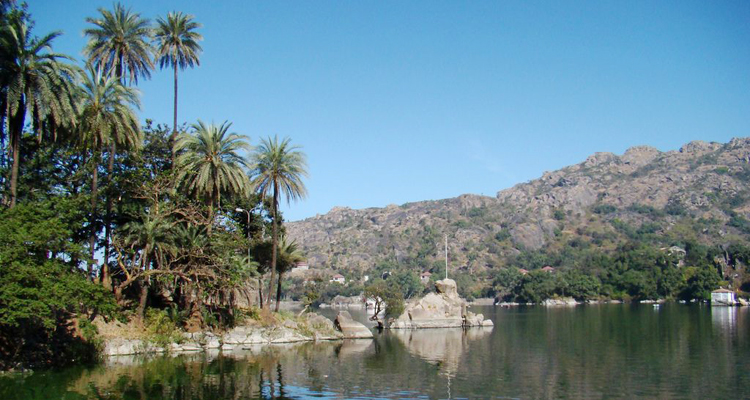Mount Abu is a popular hill station in the Aravalli Range in Sirohi district of Rajasthan state in western India, near the border with Gujarat. The mountain forms a distinct rocky plateau 22 km long by 9 km wide. The highest peak on the mountain is Guru Shikhar at 1,722 m (5,650 ft) above sea level. It is referred to as ‘an oasis in the desert’ as its heights are home to rivers, lakes, waterfalls and evergreen forests. The nearest train station is Abu Road railway station: 28 km away.

History
The ancient name of Mount Abu is Arbudaanchal. In the Puranas, the region has been referred to as Arbudaranya (“forest of Arbhuda”) and ‘Abu’ is a diminutive of this ancient name. It is believed that sage Vashistha retired to the southern spur at Mount Abu following his differences with sage Vishvamitra. There is another mythology according to which a serpent named “Arbuda” saved the life of Nandi (Lord Shiva’s bull). The incident happened on the mountain that is currently known as Mount Abu and so the mountain is named “Arbudaranya” after that incident which gradually became Abu.
The conquest of Mount Abu in 1311 CE by Rao Lumba of Deora-Chauhan dynasty brought to an end the reign of the Parmars and marked the decline of Mount Abu. He shifted the capital city to Chandravati in the plains. After the destruction of Chandravati in 1405, Rao Shasmal made Sirohi his headquarters. Later it was leased by the British government from the then Maharaja of Sirohi for use as the headquarters.
Places to visit in Mount Abu
Nakki Lake: Recognized as the first ever manmade lake in India, Nakki Lake is also a preferred place to see in Mount Abu. You can choose to take a boat ride at the lake and watch the sun set past the beautiful hills surrounding this place. Nakki Lake is also popular for being the place where the ashes of Mahatma Gandhi had been immersed. Toad rock, a place for sightseeing in Mount Abu is located close to Nakki Lake.
Dilwara Jain Temple: Established some time in between the 11th and 13th centuries, the Dilwara Jain temples are considered to be among the best specimens of architectural perfection in the country. A complex of five temple structures, the Dilwara Jain temples are located at a distance of about 2.5 kilometres from Mount Abu. Carved out of white marble, these temples features interiors that have intricate designs spreading everywhere from doorways to ceilings. Dilwara Jain temples are a must visit place in Mount Abu.
Mount Abu Wildlife Sanctuary: Covering 288 square kilometres of area, the Mount Abu Wildlife Sanctuary is a part of the subtropical forest in this region. Containing rich flora and fauna, this sanctuary allows you to come close to some rare and exotic species of wild animals, including the Indian fox, pangolin, grey jungle fowl, striped hyena, and also Indian leopard, the apex predator here.
Achalgarh Fort: Without doubt one of the most visited places in Mount Abu, the Achalgarh Fort is located about 26 kilometres north of the city. Originally built by the Paramara dynasty, this fort has later been renovated and renamed as Achalgarh by Maharana Kumbha in 1452 C.E. Another popular place to visit near Mount Abu, the Achaleshwar Mahadev Temple, is located right outside this fort.
Peace Park: Nestled in between two famous Aravali peaks, the Guru Shikhar and Achalgarh, the Peace Park in Mount Abu is a part of the Brahma Kumaris’ establishment. With an ambiance that creates the perfect blend of serenity and tranquillity, the park offers a beautiful backdrop for silence and peaceful recreation. At the Peace Park, one can visit the rock garden that houses a wide variety of Cactaceae, the orchard, citrus corner, and view the numerous floral displays that include coleus, shrubs, hibiscus, creepers and climbers, and an exquisitely beautiful rose garden. The park also has a number of areas, like a stone cave and huts, where people can meditate in a tranquil environment. The Brahma Kumaris also provide a guided tour of the park, and you can also watch a short video film that explains interesting meditation concepts. This place of solitude in the lap of nature is something you must experience.
How to Reach Mount Abu
By Road: Mount Abu is well connected by buses, some buses take you directly to the Mount Abu & some terminate at Abu Road. There are daily express & deluxe buses to Jaipur, Ajmer, Udaipur, Jodhpur, Ahmedabad, Jaisalmer & Delhi. Best way to get there is to pick a luxury cab from Udaipur.
By Rail: Abu Road is on the broad-gauge line between Mumbai & Delhi, so here are so many express trains from AbuRoad station. The Ahmedabad Mail departs from Abu Road at 1:05 PM & reaches Ahmedabad at 5:25 PM, the same train leaves to Jaipur at 2:20 PM & arrives at 11:25 & Delhi at 5:20 AM. The Tawi Express departs for Jodhpur at 3:25 PM & take five hours.
By Air: Nearest airport is Dabok Airport, Udaipur i.e. 210 kms.


